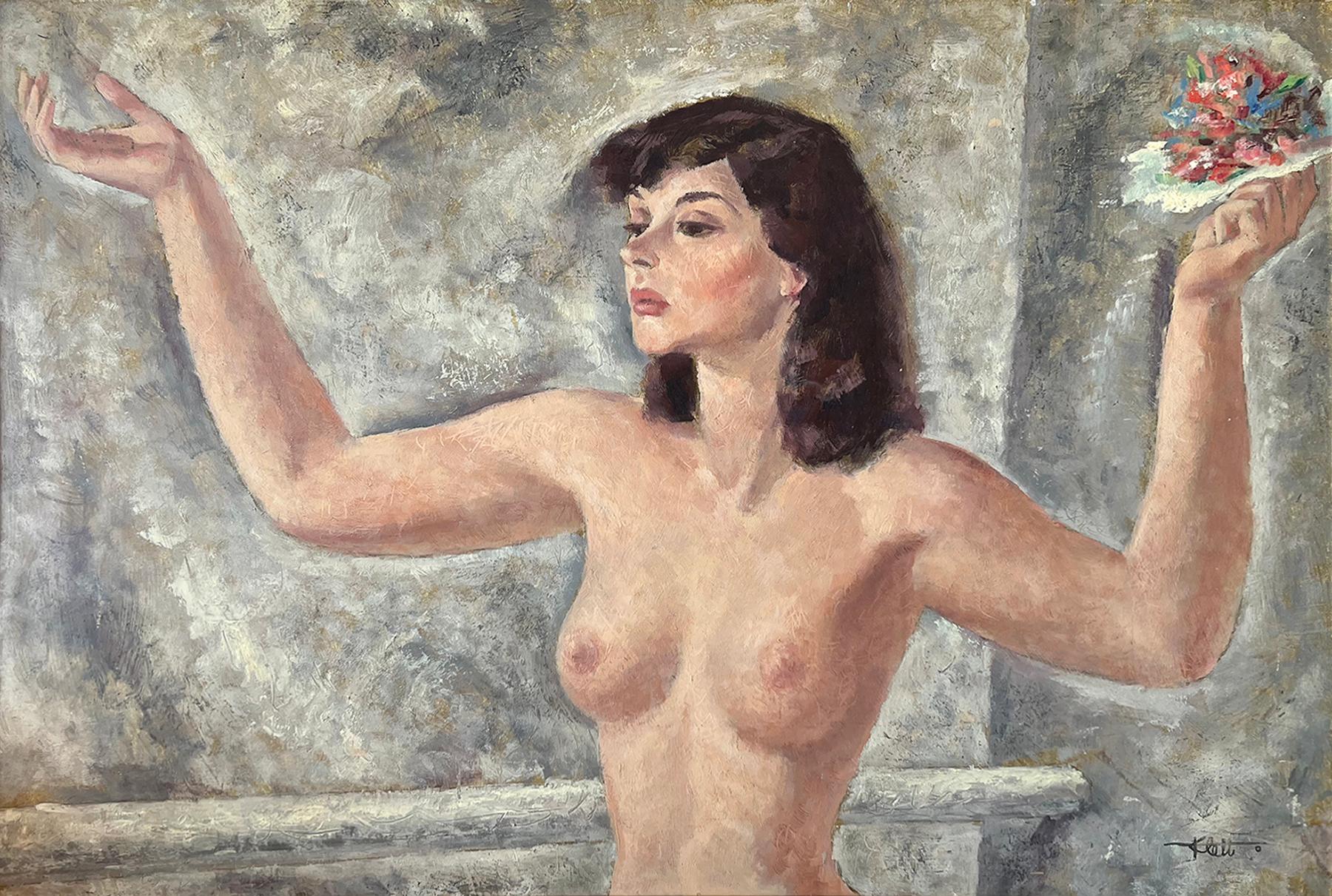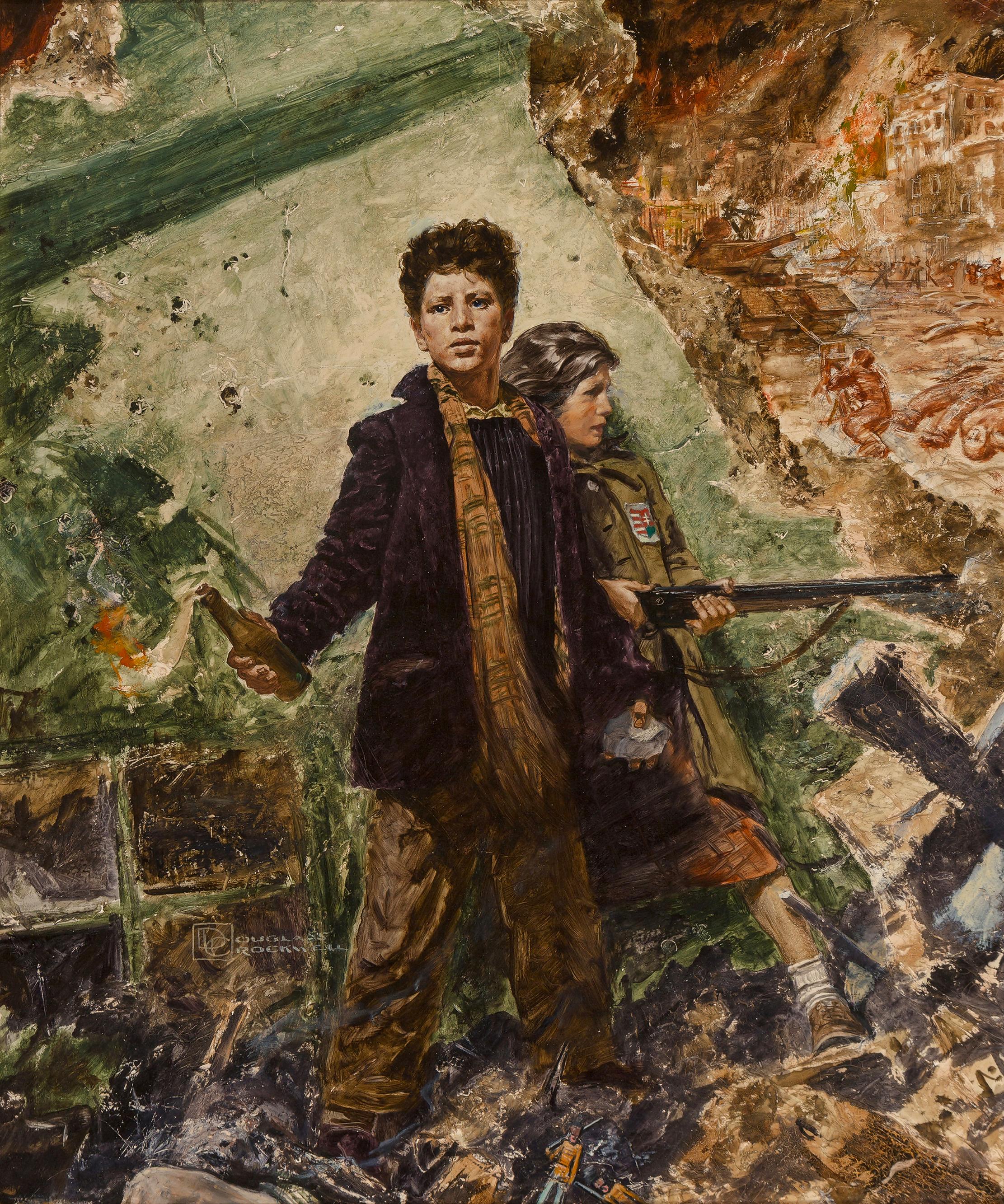Items Similar to "Clowns: Aren't We All?" Henry Glintenkamp, WPA Era Circus Figures, Modern
Want more images or videos?
Request additional images or videos from the seller
1 of 10
Hendrik Glintenkamp"Clowns: Aren't We All?" Henry Glintenkamp, WPA Era Circus Figures, Modern1942
1942
About the Item
Hendrik (Henry) J Glintenkamp
Clowns: Aren't We All?, 1942
Signed lower left; signed, titled and dated on the reverse
Oil on Masonite
20 x 16 inches
The painter and illustrator Henry Glintenkamp (1887-1946) is known mainly for his anti-war illustrations that appeared in The Masses and other publications in the early twentieth century. As a painter, he was additionally successful, particularly in his landscape and urban scenes. Born in Augusta, New Jersey, the son of Hendrik and Sophie Dietz Glintenkamp, Henry received his elementary art training at the National Academy of Design (1903-06) before his study with Robert Henri the two years following.
Henri consequently attracted artists like Glintenkamp interested in returning to a sense of human qualities. Setting up his studio in the Lincoln Arcade Building with Stuart Davis and Glenn O. Coleman, Glintenkamp did work that reflects a preoccupation with urban scenes and landscapes.
In May of 1910 Glintenkamp exhibited his works as a student at the Henri School and at the Exhibition of Independent Artists of 1910. Two years later, he accepted the position of instructor at the Hoboken Arts Club in New Jersey and in 1913, he took up with others in the organization of The Masses, designed as a publication devoted to humanitarian causes. This publication stood in stark opposition to war, as its articles and cartoons reflected pacifism. At the Armory Show (1913), Glintenkamp exhibited The Village Cemetery. In 1917, Glintenkamp moved to Mexico to avoid the draft, and remained there until 1924, supporting "the socialist agenda of Mexico's new leadership."
The period following 1917 marks a new phase in the artist's development. Brighter in color and compositionally more involved, his later works are more discordant than the artist's earlier work. The artist sacrificed the atmospheric quality of the limited palette for the increased influence of modernist movements. After extensive travels in Europe, Glintenkamp returned to New York in 1934, and became a teacher at the New York School of Fine and Industrial Art and the John Reed Club School of Art. As chairman for the committee responsible for the organization of an Exhibition in Defense of World Democracy, in 1937, Glintenkamp continued his humanitarian purpose, though never really took up with the socialist rebels, many of whom followed similar groups and publications. Indeed, Glintenkamp was instrumental in founding the American Artists' Congress; he continued serving its needs as both the organization's president and secretary. A peripheral member of the impressionist-tonalist group in his early career, Glintenkamp had progressed through many American movements by the time of his death in 1946.
- Creator:Hendrik Glintenkamp (1887 - 1946, American)
- Creation Year:1942
- Dimensions:Height: 26 in (66.04 cm)Width: 21.5 in (54.61 cm)
- Medium:
- Movement & Style:
- Period:
- Condition:
- Gallery Location:New York, NY
- Reference Number:1stDibs: LU1841214152632
About the Seller
5.0
Platinum Seller
These expertly vetted sellers are 1stDibs' most experienced sellers and are rated highest by our customers.
Established in 2021
1stDibs seller since 2022
59 sales on 1stDibs
Typical response time: 1 hour
- ShippingRetrieving quote...Ships From: New York, NY
- Return PolicyA return for this item may be initiated within 3 days of delivery.
More From This SellerView All
- "Tully Lumber Mill, Orange, Massachusetts, " Dorothy Eaton, WPA Factory RuralLocated in New York, NYDorothy Eaton Tully Lumber Mill, Orange, Massachusetts, 1935 Signed and dated lower right Oil on canvas 17 1/2 x 23 1/2 inches Dorothy Eaton was born in East Orange, New Jersey in 1893. She studied at Smith College...Category
1930s American Realist Landscape Paintings
MaterialsCanvas, Oil
- "Playground, Carl Schurz Park" George Picken, New York City, East River, UES WPABy George PickenLocated in New York, NYGeorge Picken Playground, Carl Schurz Park, 1938 Signed and dated lower left Oil on canvas 28 x 36 inches Provenance: Estate of the artist A native New Yorker, George Picken was born in 1898. His father, an artist and photographer, emigrated from Scotland; his mother came from Wales. They joined other European immigrants settling in New York City’s Hell’s Kitchen. Picken enlisted in the army during World War I and saw action at Verdun. After the war, he stayed in France and like many Americans returning from the vibrant Paris art scene, was inspired by the radical movement known as Impressionism. Upon his return Picken decided to follow in his father’s footsteps and become an artist. George began his studies in 1919 at the Art Students League during Robert Henri, Max Weber, and John Sloan’s tenure. There he took classes in studio art, illustration, and etching through 1923 studying extensively with George Bridgman. The writings of French philosopher Henri Bergson were widely circulated among the artistic community and looking at Picken’s early paintings one cannot help but wonder if as a young artist he was influenced by Bergson’s ideas. Bergson said, "[There are] two profoundly different ways of knowing a thing. The first implies that we move round the object; the second that we enter into it. The first depends on the point of view at which we are placed and on the symbols by which we express ourselves. The second neither depends on a point of view nor relies on any symbol. The first kind of knowledge may be said to stop at the relative; the second, in those cases where it is possible, to attain the absolute.” Picken’s recognition came early with showings of his work while he was a student. His drawings were published in the New Masses, a significant left-wing publication. The New York Public Library honored him with one-man shows in 1924 and 1928 and his work was included in group exhibitions at the Louis Comfort Tiffany Foundation, the Whitney Studio Club, Montross Gallery, and the Art Students League. During this time Picken married Viola Carton, one of Reginald Marsh’s models, and they lived in Westchester. Later they moved to Yorkville in Manhattan between 82nd street and East End Avenue where they began their family. Picken’s grandson Niles Jaeger recalled that, “Grandpa’s home and studio were in a five-story walk-up apartment, heated only by a coal stove. But there were wonderful views of the East River and the Queensborough Bridge...Category
1930s American Realist Landscape Paintings
MaterialsCanvas, Oil
- "Senator" William Gropper, Social Realism, WPA Political Art, CaricatureBy William GropperLocated in New York, NYWilliam Gropper Senator Signed lower center Oil on board 16 x 12 1/4 inches ACA Galleries, New York Private Collection, New York Bonhams, American Art Online, August 23, 2023, Lot 3...Category
Mid-20th Century American Realist Figurative Paintings
MaterialsOil, Board
- "Standing Figure, " Nicholas Sperakis, Rhino Horn Group, American RealistBy Nicholas SperakisLocated in New York, NYNicholas George Sperakis (American, b. 1943) Standing Figure, n.d. Oil and paper on canvas 60 x 42 inches Signed and titled on the reverse Nicholas Sperakis, the youngest of the original Rhino Horn...Category
Late 20th Century American Realist Figurative Paintings
MaterialsCanvas, Paper, Oil
- "Three Engineers, " Albert Pels, Men at Table with Compass, WPA, American RealismBy Albert PelsLocated in New York, NYAlbert Pels (1910 - 1998) Three Engineers, circa 1935 Oil on board 10 x 13 1/2 inches Signed lower right Albert Pels was an art educator and painter of figures, genre scenes, urban ...Category
1930s American Realist Figurative Paintings
MaterialsOil, Board
- "Neighborhood Shivaree, " Fred E. Robertson, Grandma Moses, Self-Taught LandscapeLocated in New York, NYFred E. Robertson (1878 - 1953) Neighborhood Shivaree, 1945 Signed and dated lower left Oil on masonite 16 x 20 inches Exhibited: Buffalo, The Buffalo Fine Arts Academy, Albright A...Category
1940s Folk Art Landscape Paintings
MaterialsMasonite, Oil
You May Also Like
- Raymond Howell, Chinese Dim Sum Feast, 1979, Oil Painting on MasoniteLocated in San Francisco, CARaymond Howell, Chinese Dim Sum Feast, 1979 Oil on masonite 28" x 36" unframed, 35.5" x 43. 75" framed Biography from Raymond Howell website: Raymon...Category
20th Century American Realist Figurative Paintings
MaterialsMasonite, Oil
- Elegant Nude Woman in Dancing - Mid-Century MonochromaticBy Walter Charles KlettLocated in Miami, FLExcellent Mid-century nude by famous illustrator/ artist Walter Charles Klett. The work is masterfully painted with a sound understanding of the basic academic principles guiding t...Category
Mid-20th Century American Realist Nude Paintings
MaterialsOil, Masonite
- Market Place, Taxco Mexico, Oil Painting by Fil MottolaBy Fil MottolaLocated in Long Island City, NYArtist: Fil Mottola, American (1915 - 2008) Title: Market Place, Taxco Mexico Medium: Oil on Masonite, signed l.r. Size: 30 x 40 inches [76 x 102.5 cm] Framed: 38 x 48 inches [96.5 ...Category
1980s American Realist Figurative Paintings
MaterialsMasonite, Oil
- Boy with Molotov Cocktail, Russia Invades GermanyBy Spencer Douglass CrockwellLocated in Miami, FLThis work sells itself. Just look at it and an elaborate explanation is not required. There is virtually no one alive who can paint a picture like Crockwell. Hand-signed by artist, sticker label, Signed lower left Provenance: National Museum of American Illustration , Newport, Rhode Island Crockwell gives us a complex and inventive composition by showing two wonderful portaits in the foreground and beyond a broken wall...Category
1940s American Realist Figurative Paintings
MaterialsMasonite, Oil
- Mary Vincent and the Convict, Good Housekeeping Illustration - Mid CenturyBy Al ParkerLocated in Miami, FLAl Parker was one of America's greatest and most inventive illustrators. He did work for magazines such as: Chatelaine, Collier's, Ladies' Home Journal and Woman's Home Companion. ...Category
1950s American Realist Figurative Paintings
MaterialsMasonite, Gouache, Pencil
- Colliers Magazine 1947 American Scene Social Realism Modern Families in the SnowLocated in New York, NYColliers Magazine 1947 American Scene Social Realism Modern Families in the Snow Katherine Wiggins (American 20th Century) "The Shrimp" 20 x 24 inches Egg tempera on masonite. c. 1...Category
1940s American Realist Figurative Paintings
MaterialsEgg Tempera, Masonite




